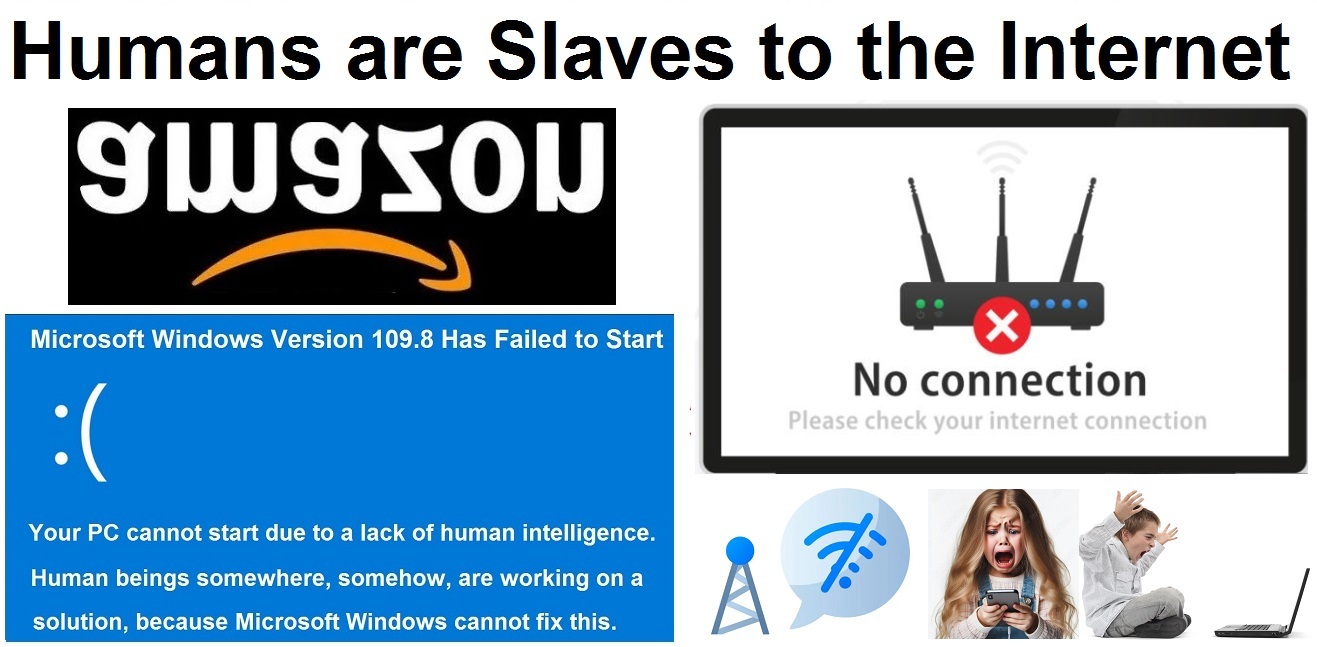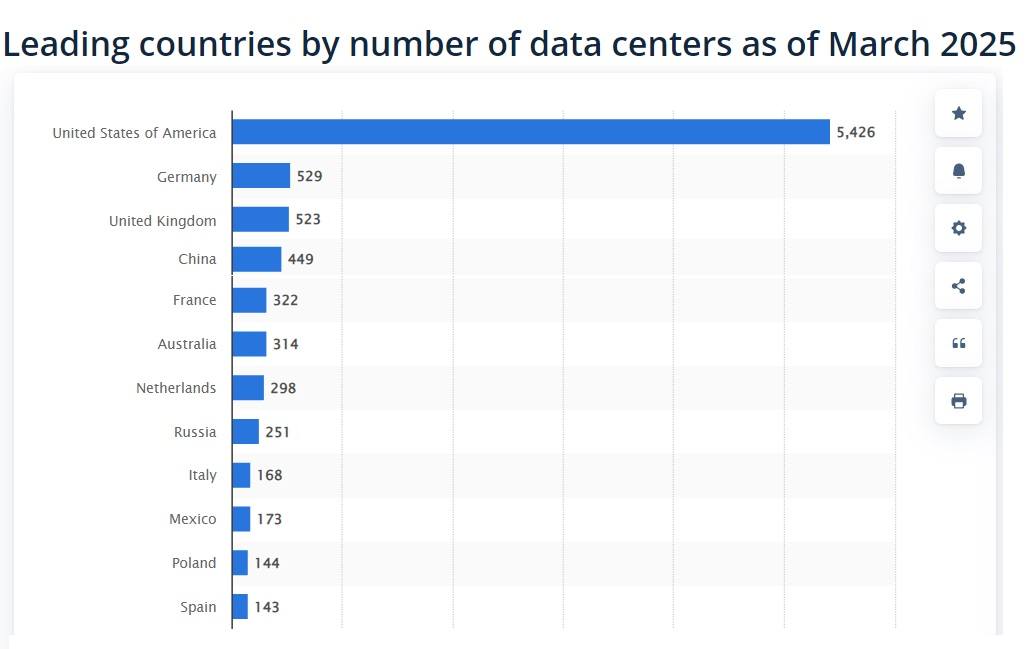
by Brian Shilhavy
Editor, Health Impact News
In the wake of the Amazon Web Services (AWS) outage earlier this week, there have been numerous articles published in the media concerning just how vulnerable our society has become to just a few Big Tech companies here in the U.S. who control most of the Internet.
Government services, banks, smart homes, cell phone services, the retail market and just about every other facet of our society today depends upon the Internet to keep things running, and most of the Internet now is hosted in huge Cloud data centers.
About 70% of these data centers are owned by Amazon, Microsoft, and Google.
Others are ramping up spending to get a piece of this pie, such as Larry Ellison’s Oracle, with his close ties to Trump.
And the main driver in the economy right now that is putting more and more of the Internet traffic into these data centers, is the AI bubble.
This is a recipe for disaster, as I have been saying for years, and that others are now beginning to realize as well.
Not only is the technology prone to accidents and failures, as technology ALWAYS has been, but they are also huge targets to hackers and cyberattacks.
A new report [1] published just this week found that for the first time in years, the United States is no longer making progress in bolstering its cyber defenses and is instead “stalling” and “slipping” in its ability to protect itself and allies.
The primary reason for this is because IT technicians can make so much more money developing AI, which is where all the money is going in the private sector.

But even the private sector spending $trillions on AI is running into a new obstacle: China controls 90% of the world’s rare earth supplies that are needed to build these energy hungry computer chips, and they are not selling them anymore unless the country purchasing them can prove that they are not being used for military purposes [2], which pretty much excludes Big Tech in the U.S., because they are all defense contractors.

The United States has more data centers than almost the rest of the world combined. Image source [3].
Here are some recent articles published this week in the national media that recognize that this situation with Big Tech is a national crisis.
From CNN [4]:
You thought Monday’s internet outage was bad? Just wait
Monday’s Amazon Web Services outage — and the global disruption it caused — underscored just how reliant the internet has become on a small number of core infrastructure providers.
The ramifications of such outages could only get worse if artificial intelligence becomes as central to work and daily life as tech giants suggest it will in the coming years.
Monday’s outage briefly blocked some people from scheduling doctor’s appointments and accessing banking services. But what if an outage took down the AI tools that doctors were using to help diagnose patients, or that companies used to help facilitate financial transactions?
It may be a hypothetical scenario today, but the tech industry is promising a rapid shift toward AI “agents” doing more work on behalf of humans in the near future – and that could make businesses, schools, hospitals and financial institutions even more reliant on cloud-based services.
A global survey of nearly 1,500 firms published by McKinsey & Company in May found that 78% of respondents already use AI in at least one business function, up 55% from a year earlier.
“If there’s an outage and you rely on AI to make your decisions and you can’t access it, that’s going to have an effect on performance,” said Tim DeStefano, associate research professor at Georgetown’s McDonough School of Business.
Monday’s outage had such a widespread impact because many companies rely on cloud providers for the backend functions that support their businesses, such as virtual server space, storage or developer tools.
Typically, this set up is more affordable, flexible and secure for those customers, except when AWS experiences an outage. Then it’s effectively a single point of failure for a huge swath of the internet.
AWS serves millions of customers, from retailers and restaurants to financial services firms and government agencies; it holds around 37% of the cloud computing market, according to Gartner. Together with Microsoft and Google, the three companies service around 70% of the market.
And the consolidation of the internet’s backbone is continuing in the age of AI.
While there’s some grappling between the big three, Amazon, Microsoft and Google remain by far the prominent cloud computing providers for AI applications, according to Emarketer senior analyst Jacob Bourne — and their futures depend at least in part on serving AI demand.
While websites and apps can still technically function using their companies’ own less powerful on-premises servers,
“cloud computing represents a technological prerequisite for using AI,” DeStefano said.
That’s because the computers needed to run AI tools are powerful and expensive, and on-site hardware isn’t as easy to modify as business needs change. It just makes more sense to rent that computer space and pay for it only as needed.
And as AI becomes more widespread, data center outages could happen more frequently since AI models are so power-hungry, Bourne said.
The risk of serious disruption from an outage rises considerably the more companies rely on AI agents to do critical tasks and automate the work of humans, a transition that’s already in progress despite disagreement about just how far it will go. (Source [4].)
From GeekWire [5]:
Concentration crisis in AI
With the generative AI ecosystem, I’m talking not about chatbots — I mean AI-native applications that are built on generative AI as a platform. We just saw that when there’s no cloud, there’s no cloud-native application. Likewise, when there’s no generative AI provider, there’s no AI-native application.
The first lesson from the AWS outage for AI-native applications is what happens to an industry when there’s a limited number of providers for centralized resources and there’s an outage. We just saw: it has huge rippling effects across the industry and all walks of life built on it.
It’s a throwback to the mainframe era: when “the computer” is down, it’s down for everyone.
There are as few, if not fewer, generative AI providers as there are cloud providers. A major outage is inevitable — that’s just engineering reality. When that happens, every AI-native app built on that generative AI platform will also go down, full stop.
The impact could be even more severe than the AWS outage. It will be more like “the computer is down, and the people are gone” for many different industries and services.
Ironically, the “smarter” the industry and service, the greater the potential fallout.
The second lesson is one of intertwined risk. OpenAI itself was affected by this week’s AWS outage.
That means AI-native apps have double exposure to the risks around a limited number of providers for critical, centralized resources. For AI-native apps, it’s like the mainframe era squared.
If the generative AI platform fails, everything built on it fails. And if the cloud that hosts the AI platform fails, it all goes down, too.
Highly concentrated risks with exceptionally broad impact aren’t going away anytime soon.
A thoughtful application of the AWS outage tells us that outages like this are a kind of problem that isn’t an anomaly: it’s inherent in the nature of today’s technology reality. (Source [5].)

This article by The Guardian [6] points out a fact that I recently published [7], which is that Amazon’s main data center in the U.S. is in northern Virginia, which is also home to the CIA who uses AWS, and is home to 70% of the world’s internet traffic.
An outage that showed who really runs the Internet
A failure at Amazon’s server centre paralysed global services for 15 hours. It was not just a glitch but a stark reminder of our digital dependency and fragility
Excerpts:
An outage at Amazon Web Services (AWS) on Monday disrupted apps and websites around the world, affecting more than 2,000 companies and leaving millions of users unable to access services like Snapchat, Roblox, Signal, Duolingo and even Amazon’s own operations.
Removing the tech from our tech-dependent existence led to workers being sent home and exams delayed. The crash, which lasted 15 hours, underlined how deeply our digital lives depend on a small number of cloud providers – and how vulnerable many everyday systems are to a single failure.
If data is the new oil, then cloud computing is the pipeline, the refinery, the tanker fleet and, increasingly, the pump too.
The big three – AWS, Microsoft Azure and Google Cloud – account for 60% of global cloud computing. They own the networks and cables that move data across the world.
Their platforms don’t just turn data into useful insights – they do it with proprietary tools that make switching providers costly and complex. Finally, through Amazon’s Alexa, Google Workspace and Microsoft 365, they are also shaping how people interact with data and services.
It’s easy to forget that all the information processing has to happen in buildings full of servers connected to the internet via fibre-optic cables. Amazon’s biggest and most critical cloud region, known as US-EAST-1, is located in northern Virginia and is home to 70% of the world’s internet traffic.
Virginia’s role in web traffic is comparable to the strait of Hormuz for oil tankers – a narrow choke point through which vital commerce flows.
It is vulnerable not only to technical error but to cyber-attacks, geopolitical sabotage and terrorism.
This was the cluster’s third major outage in five years, each leading to an internet meltdown.
In a paper [8] for University College London, Francesca Bria, Paul Timmers and Fausto Gernone warn that cloud computing is the power grid of the 21st-century economy.
Europe’s public services, industrial innovation and AI ambitions are increasingly built on a digital backbone it does not own, regulate or even fully understand.
In that respect, this week’s outage is no technical blip. It is a warning shot. (Source [6].)

Learn more here [9].
US Cyber Progress Stalls for First Time in Years, Report Says
From MeriTalk [1]:
For the first time in years, the United States is no longer making progress in bolstering its cyber defenses and is instead “stalling” and “slipping” in its ability to protect itself and allies, the successor organization to the U.S. Cyberspace Solarium Commission (CSC) revealed in a report published Wednesday.
CSC 2.0, led by the Foundation for the Defense of Democracies, said that while presidential transitions tend to slow cybersecurity progress, the Trump administration’s recent personnel cuts at the Cybersecurity and Infrastructure Security Agency (CISA) and the State and Commerce Departments have “further eroded momentum.”
“This year’s assessment makes clear that technology is evolving faster than federal efforts to secure it,” the report [10] says.
The CSC, established in 2019, was congressionally chartered to develop a comprehensive strategy to defend the United States against cyber threats and strengthen the nation’s overall cybersecurity posture.
This year’s report found that just 35% of the commission’s 82 recommendations are fully implemented – down from 48% last year – marking the first significant reversal in progress, as nearly a quarter of completed actions have slipped backward, and overall implementation has stalled.
Since entering office, the Trump administration has dramatically cut down the federal workforce, laying off tens of thousands and attempting to cut budgets for agencies typically responsible for critical cybersecurity protections.
Earlier this year, the administration recommended a 17% cut to CISA’s budget and eyed a 29% cut to CISA’s workforce – which has reportedly undergone major reassignments during the government shutdown to other Department of Homeland Security components focused on immigration enforcement. (Full article [1].)
China Controls the World’s Rare Earth Materials
China controls 90% of these rare earths that are needed by Big Tech, so whatever announcement Trump makes about securing more from other countries is simply trying to get more out of the other 10%.
From CNN [11]:
Trump is trying to break China’s monopoly on rare earths, but can’t cut deals fast enough to catch up
As Beijing weaponizes its dominance over rare earths supplies, US President Donald Trump is cutting deals to try to break the stranglehold. But his claim that America will have an abundance of the critical minerals in just one year’s time may be a fantasy.
“In about a year from now, we’ll have so much critical mineral and rare earths, and you won’t know what to do with them,”
Trump said Monday, after unveiling a $8.5 billion agreement to help Australia develop rare earths projects and secure United States access to those elements.
China controls more than 90% of the global output of refined rare earths, which are used to power everything from iPhones to electric vehicles, and this near-monopoly has become one of its most potent tools in its trade war with the US.
Rare earths emerged as a major sticking point between China and the US earlier this year after Beijing imposed unprecedented export controls on the critical minerals, which led to shortages worldwide, disrupting supply chains.
China’s move this month to tighten control of even trace amounts of China-processed rare earths in other countries sent shockwaves through global manufacturing and prompted Trump to threaten 100% tariffs on Chinese goods –– adding fresh uncertainty to the already tumultuous relationship between the world’s two largest economies.
Under Monday’s deal, the US and Australian governments intend to invest, in the next six months, more than $3 billion in critical minerals projects, expected to yield a value of $53 billion, the White House said.
It is unclear when production from the new projects will begin.
The deal has the potential to put Australia in an even more awkward position with its largest trading partner, China.
Although rare earths, a group of 17 elements, are in fact more abundant than gold, the relatively high cost and environmental damage associated with their processing and refinement have placed China in a dominant position in their production worldwide.
Between 2020 and 2023, the US was dependent on China for 70% of its imports of all rare earths compounds and metals, according to a report by US Geological Survey, an agency under the interior department.
And in a note Monday, Goldman Sachs estimated that disruption to just 10% of production in industries dependent on these elements could wipe out $150 billion in US economic output. (Source [11].)
Don’t Be a Slave to the Internet! Time to Unplug!
See:
The Post-Technological Age is Drawing Closer as Gen Z Starts Unplugging [12]
Comment on this article at HealthImpactNews.com [13].
This article was written by Human Superior Intelligence (HSI) [14]
[14]
See Also:
Understand the Times We are Currently Living Through
The Demonic Roots of Christianity: The Christians Jesus Said He Hated [16]
Who are God’s “Chosen People”? [17]
Life in the Spirit versus the Religious Life in the Flesh [18]
KABBALAH: The Anti-Christ Religion of Satan that Controls the World Today [19]
 [19]
[19]
Christian Teaching on Sex and Marriage vs. The Actual Biblical Teaching [20]
Exposing the Christian Zionism Cult [21]
The Bewitching of America with the Evil Eye and the Mark of the Beast [22]
Jesus Christ’s Opposition to the Jewish State: Lessons for Today [23]
Identifying the Luciferian Globalists Implementing the New World Order – Who are the “Jews”? [24]
The Brain Myth: Your Intellect and Thoughts Originate in Your Heart, Not Your Brain [25]
The Seal and Mark of God is Far More Important than the “Mark of the Beast” – Are You Prepared for What’s Coming? [26]
The Satanic Roots to Modern Medicine – The Image of the Beast? [27]
Medicine: Idolatry in the Twenty First Century – 10-Year-Old Article More Relevant Today than the Day it was Written [28]
 [29]
[29]
Having problems receiving our emails? See:
How to Beat Internet Censorship and Create Your Own Newsfeed [30]
We Are Now on Telegram [31]. Video channels at Bitchute [32], and Odysee [33].
If our website is seized and shut down, find us on Telegram [31], as well as Bitchute [32] and Odysee [33] for further instructions about where to find us.
If you use the TOR Onion browser [34], here are the links and corresponding URLs to use in the TOR browser [34] to find us on the Dark Web: Health Impact News [35], Vaccine Impact [36], Medical Kidnap [37], Created4Health [38], CoconutOil.com [39].















